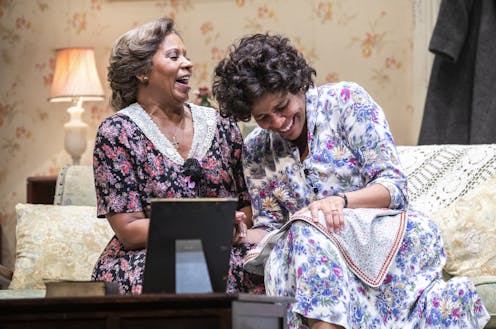Sydney Theatre Company’s A Raisin in the Sun is an enormous achievement with superb cast, direction and staging
- Written by Sarah Gleeson-White, Associate Professor in American Literature, University of Sydney

Review: A Raisin in the Sun, directed by Wesley Enoch for the Sydney Theatre Company.
It is hard to believe the Sydney Theatre Company’s production of Lorraine Hansberry’s award-winning A Raisin in the Sun (1959) is its Australian mainstage premiere – nearly 65 years after it appeared on Broadway with the magnificent Sidney Poitier in one of the lead roles.
The first play on Broadway written by an African American woman, A Raisin in the Sun was nominated for four Tony Awards, including for best play, and went on to win the New York Drama Critics’ Circle Award for Best Play of the Year.
Arguably one of the most compelling narratives of 20th century Black American life, Hansberry’s play remains a stalwart in the American literary canon.
Across a compressed several weeks, A Raisin in the Sun traces the hopes and dashed dreams of three generations of the African American Younger family, headed by matriarch, Lena (Gayle Samuels).
Written five years after the Supreme Court’s Brown v. Board of Education[1] ruling, which put an end to legal school segregation, and four years after the Montgomery bus boycott[2], this just might be, as Black poet Amiri Baraka declared it[3], the “quintessential civil rights drama”.
Read more: A must-read list: The enduring contributions of African American women writers[4]
A sense of entrapment
Hansberry’s scathing narrative of postwar American race relations stands up well to the test of time, and this production, directed by Wesley Enoch, is superb.
The rapport among the actors, including those in more minor roles, is palpable. This is a true ensemble piece.
Samuels and Zahra Newman (as Ruth Younger) both give particularly compelling performances, and Nancy Denis is hilarious as their nosy neighbour Mrs Johnson.
Together, the cast really succeeds in drawing out Hansberry’s humour, and thus the play’s often jarring shifts between comedy, satire and tragedy.
The play unfolds in the single setting of the family’s shabby, rat-infested apartment on Chicago’s Southside. Mel Page’s smart set design means we can see into its two small bedrooms at all times, giving a real sense of the family’s entrapment, and heightening the escalating conflicts.
As the play opens, the family anxiously awaits the delivery of the recently deceased Mr Younger’s life-insurance cheque, a prospect that provokes each of the family members to disclose their hopes and wishes, embodied in the raggedy pot plant Lena carefully tends throughout.
Lena yearns to provide her family with a home. Her son Walter Lee (Bert Labonté) yearns to join the ranks of the Black middle class. Her daughter, Beneatha (Angela Mahlatjie) yearns to become a medical doctor to “make [people] whole again”.
Yet the aspirations Black Americans like Walter Lee and Beneatha nurtured are impossible in this era of segregation.
Lena does succeed in achieving her dream: she purchases a house for her family, but it is in the white neighbourhood of (fictional) Clybourne Park.
This twist generates an encounter between the family and the only white character in the play, Karl Lindner (Jacob Warner), spokesman for the Clybourne Park community, which wants to buy the house from the Youngers to keep the neighbourhood “respectable”.
As Beneatha observes, when Lena asks whether Lindner threatened the family:
they don’t do like that anymore. He talked Brotherhood. He said everybody ought learn how to sit down and hate each other with good Christian fellowship.
Read more: 'Our ultimate choice is desegregation or disintegration' – recovering the lost words of a jailed civil rights strategist[5]
A heavy load
Hansberry took the title of her play from Langston Hughes’ 1951 poem, Harlem[6]. Pondering “a dream deferred,” Hughes writes:
Does it dry up like a raisin in the sun? Or fester like a sore
Reviewers and critics of A Raisin in the Sun frequently rush to claim the universality of this narrative of postwar Black American life. In such an approach, we risk losing what is specific to the festering sore of Jim Crow America. We also miss the play’s significance in light of our own moment of global racial foment, of Black Lives Matter, and much else.
In a 1959 interview, Hansberry told radio host[7] Studs Terkel:
In order to create the universal, you must pay very great attention to the specific.
This production of A Raisin in the Sun is an enormous achievement – thanks not only to its superb cast, direction and staging, but too, the Sydney Theatre Company’s commitment to attending to the specific, to telling stories we still need to hear.
A Raisin in the Sun is at Wharf 1 Theatre until October 15.
Read more: Langston Hughes – domestic pariah, international superstar[8]
References
- ^ Brown v. Board of Education (en.wikipedia.org)
- ^ Montgomery bus boycott (en.wikipedia.org)
- ^ declared it (www.goodreads.com)
- ^ A must-read list: The enduring contributions of African American women writers (theconversation.com)
- ^ 'Our ultimate choice is desegregation or disintegration' – recovering the lost words of a jailed civil rights strategist (theconversation.com)
- ^ Harlem (www.poetryfoundation.org)
- ^ told radio host (www.lhlt.org)
- ^ Langston Hughes – domestic pariah, international superstar (theconversation.com)

















